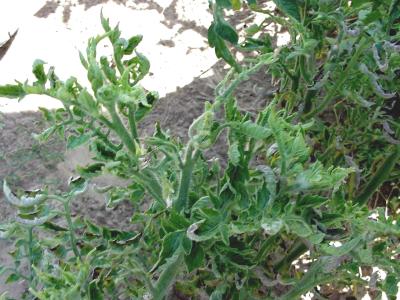
|
Tomato Yellow Leaf Curl Virus Disease (TYLCV)
Order/Family:
Geminiviridae: Begomovirus {GEM2}
Type:
disease (viral)
Host plants: Beans
Tomato
|
| General Information on Disease and Damage | Cultural practices | |||
| Biology and Ecology of the Tomato Yellow Leaf Curl Virus Disease | Information Source Links | |||
| Pest and Disease Management |
General Information on Disease and Damage
Geographical distribution
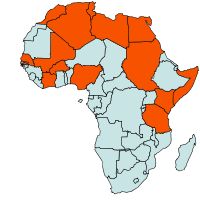 |
| Geographical Distribution of Tomato Yellow Leaf Curl Virus Disease in Africa (red marked) |
Damage
The virus affects yields by greatly reducing the number of fruit produced. Fruit developing at the time of infection remain on the plant, but very few fruit will set once infection has occurred. Symptoms
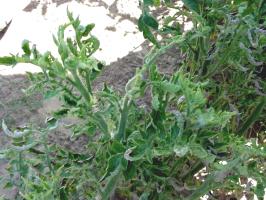 |
| Tomato yellow leaf curl virus. Note thickened shoots. |
| © A.A. Seif, icipe |
Affected leaves are curled upwards or inwards. Flower drop is common, and therefore infected plants have a reduced number of flowers and fruit. If infection takes place at a later stage of growth, fruits already present develop normally. There are no noticeable symptoms on fruits derived from infected plants. Generally, table tomatoes are severely affected by the disease, especially when infection occurs before the flowering stage.
Host range
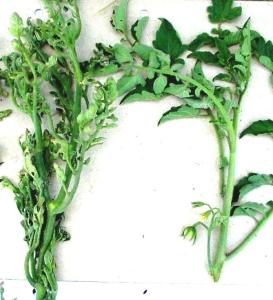 |
| Tomato yellow leaf curl virus. Note multiple shoots, thickened shoots and deformed yellow |
| © A.A. Seif, icipe |
Affected plant stages
Seedling stage, generative and vegetative growing stage.Affected plant parts
Leaves, stems and whole plant.Symptoms on affected plant part
Leaves: stunting, bushy growth; reduced size; abnormal forms. Flowers: drop.
Stems: abnormal growth.
Whole plant: dwarfing.
Biology and Ecology of the Tomato Yellow Leaf Curl Virus Disease
Source of infection and spread
The tomato yellow leaf curl virus is not seed-borne and is not transmitted mechanically. The disease is spread by whiteflies (Bemisia tabaci). Whiteflies have a wide host range. New plant growth attracts whiteflies, which feed on the lower leaf surface. It takes about 15-30 minutes for the whitefly to become infected by the virus. The incubation period is 21-24 hours, and the transmission period at least 15 min. Factors that favour development:
- High temperatures, and low or no rainfall
- Presence of whiteflies
- Infected transplants
- Weedy fields
Pest and Disease Management
Pest and disease management: General illustration of the concept of infonet-biovision
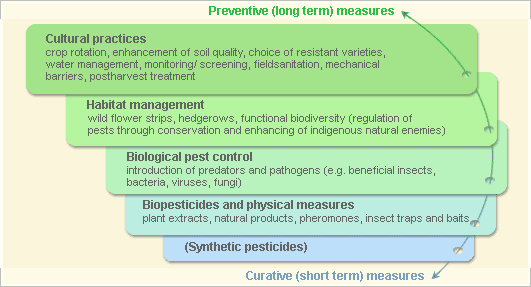
Further below you find concrete preventive and curative methods against TYLVC.
Cultural practices
- Avoid continuous growing of tomato. Practice crop rotation by planting crops that are not susceptible to whitefly.
- Use resistant/ tolerant varieties, e.g. 'Amareto', 'Peto 86', 'Fiona F1', 'Perlina', 'Denise', 'Cheyenne (E448)', 'Rover'.
- Mulch the seedbeds.
- Protect seedbeds with a white nylon net (40 mesh).
- Pull out diseased seedlings.
- Protect seedlings from whiteflies (for more information on whiteflies click here)
- Plant barrier crops like maize around tomato fields. These crops should be sown a month or two before transplanting of tomato.
- Mulch tomato fields with sawdust or straw.
- Immediately remove infected-looking plants and bury them.
- Do not plant cotton near tomato and/or other crops susceptible to whiteflies or vice versa.
- Eradicate weeds.
- Plough-under all plant debris after harvest or burn them when possible
Information Source Links
- CABI (2005). Crop Protection Compendium, 2005 Edition. © CAB International Publishing. Wallingford, UK. www.cabi.org
- Dobson, H., Cooper, J., Manyangarirwa, W, Karuma, J. and Chiimba, W. (2002). Integrated Vegetable Pest Management - Safe and sustainable protection of small-scale brassicas and tomatoes. Natural Resources Institute, University of Greenwich, UK. ISBN: 0-85954-536-9
- Food and Fertilizer Technology Centre for Asian and Pacific Region (1986). Plant Virus Diseases of Horticultural Crops in the Tropics and Subtropics. FFTC Book Series No. 33, Taiwan, Republic of China
- OISAT. Organisation for Non-Chemical Pest Management in the Tropics. www.oisat.org
- Varela, A.M., Seif, A.A. and Löhr, B. (2003). A Guide to IPM in Tomato Production in Eastern and Southern Africa. ICIPE, Nairobi, Kenya. ISBN: 92 9064 149 5 www.icipe.org

 Back
Back
